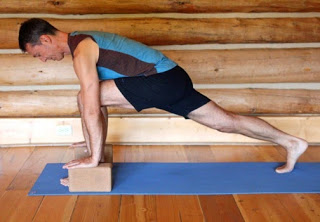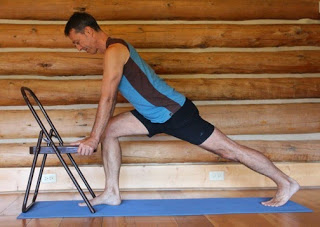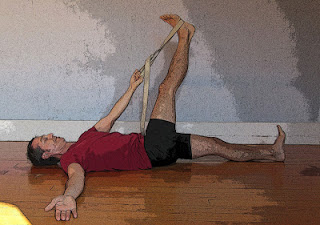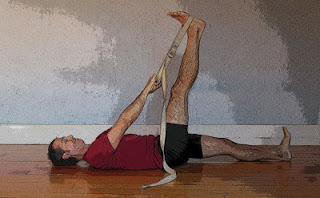Q: I have a question about hip openers. I teach to mostly middle-aged and older populations. Some folks are more physically active than others, but almost all of them spend a lot of time sitting, either in a car or at a desk. Many of them experience tightness in the hips and a smaller sub-set also have issues with painful knees – arthritis, meniscus issues, etc. I was taught that externally rotating the leg can be problematic for the knees, especially if they are already vulnerable. However it seems as though most of the best and most direct hip openers involve external rotation. Do you know of any postures that effectively stretch and release tension in the gluteals and the external rotators of the hip without compromising the safety of the knee?
I searched the blog but wasn’t able to find anything that addressed this issue, though perhaps I didn’t search effectively. I’d be grateful for any insights you can share, from previous posts, or in the future.
A: Thanks for this question! I want to begin by reminding all of us that in yoga circles “hip opening” sometimes gets reduced to the combination of hip flexion, abduction and external rotation of the femur bone (thigh bone) in the hip socket, as in Cobbler’s pose (Baddha Konasana) and Lotus pose (Padmasana). But the hip obviously moves in many other directions, so “hip opening” should reflect the improvement of the full range of motion of the hip joint! So, in general, for yourself and your students, focus on good overall hip opening, which will have positive impacts on posture, locomotion, balance, and agility.
Opening the Front of the Hip Joint
To open the front of the joint—the area your sedentary and seated students need mostly—you want to stretch the front thigh muscles, such as the quads and the psoas by extended the joint, so High Lunge (Vanarasana), including the classic and chair versions, and the Dropped-Knee Lunge, and Warrior 1 (Virabradrasana 1) for the back leg can effectively work those areas.



Opening the Inner Hip Joint
To open the inner aspect of the joint, you want to lengthen the adductor group of muscles via poses that take your legs wide apart, such as Standing Wide-Legged Forward Bend (Prasarita Padottanasana), Pyramid pose (Parsvottanasana), Triangle pose (Trikonasana) and Extended Side Angle pose (Utthita Parsvakonasana), and Wide-Angle Seated pose (Upavista Konasana).

Opening the Outer Hip Joint
To open the outer hip joint, you want to adduct the hip joint via poses that bring your leg across the midline of your body. You can do this movement with Reclined Leg Stretch (Supta Padangusthasana), bringing your lifted leg across the midline.

Standing Forward Bend (Uttanasana) with one leg crossed in front of the other can also be helpful.
Opening the Back of the Hip Joint
To open the back of the joint, stretching the hamstring stretch muscles by flexing the joint with straight legs is very helpful. Some poses that stretch the hamstrings effectively include Standing Forward Bend (Uttanasana), Reclined Leg Stretch Pose (Supta Padangusthasana) Version 1, and Pyramid pose (Parsvottanasana).

Combinations of Movements
To address combinations of movements, especially those that include external rotation of the hip joint, which is necessary for poses like Cobbler’s and Lotus poses, Thread the Needle pose is a great way to release tension in the deep external rotators of the hips.
If you hold onto the top shin and stretch your bottom leg along the floor, you are essentially doing upside down Pigeon pose without as much potential strain on the knee joint for you folks with knee issues. Sorry I don’t yet have a picture of this variation!
In fact, regular Pigeon pose (Kapotasana) is one to avoid for those with knee issues, as it tends to put too much pressure into the front bent knee, especially when doing the forward folding version.
You can also get a nice stretch of the posterior gluteal muscles in all your Downward-Facing Dog (Adho Mukha Svanasana) variations, even Half Downward-Facing Dog at the Wall.

If you then bend your left knee a bit toward the wall and press your hips a bit to the right side of your mat while keeping your right knee straight, you can get a deeper stretch of the lateral gluteal muscles and the deep external rotators of the right hip. And it is easy on the knees! Of course, do it on both sides!
Also, the twisting version of Reclined Leg Stretch pose pictured above is also a good one, as are these versions of Marichyasana 3:


If there is any knee pain when you try this one, you can move your bent knee foot slightly away from the hips.
All this should keep you and your students busy for a while!
—Baxter
Follow Yoga for Healthy Aging on Facebook ° To order Yoga for Healthy Aging: A Guide to Lifelong Well-Being, go to Amazon, Shambhala, Indie Bound or your local bookstore.


Very nice.
Great explanation. Thanks so much!
#1: Triangle
Stand with feet wider than hips (about 3 feet apart) with left toes facing side, right toes forward. Extend arms out to sides of shoulders with palms facing down and engage thighs to avoid locking out the knee joint. Reach out over left leg, slowly lowering left hand below knee – resting it on your shin, ankle or if you can reach the floor. Extend right arm up to ceiling above right shoulder. Focus up towards right hand, or if that bothers your neck, try looking straight ahead or even down at left foot.
Hold for 30-60 seconds, breathing deeply; repeat on opposite side.
#2: Supported Forward Fold
Begin seated on pillow (or folded blanket). Extend left leg in front of body, bending right knee to the side, drawing heel in as close to body as is comfortable for your knee. Take a deep breath in, sitting up tall and extending both arms overhead [A].
Hinge forward from hips and bring chest over left thigh, reaching hands towards leg or foot [B]. Fold forward to your own degree, placing hands on thigh, shin, or if you can reach, hold on to your flexed foot for a deeper stretch.
Hold for 30-60 seconds, breathing deeply; repeat on opposite side.
#3: Half Straddle Side Stretch
Extend left leg out to side of hip, flexing foot, with left hand resting on left leg. Inhale deeply, sitting tall, reaching right arm overhead [A].
As you exhale, slowly slide left hand towards foot, leaning torso to the left with right arm extending by right ear. Roll right shoulder open and try to gaze up towards the ceiling [B].
Hold for 30-60 seconds, breathing deeply; repeat on opposite side.
#4: Modified Lizard Lower Lunge
Begin kneeling on top of pillow (or folded blanket), and take a big step forward with right foot, lining up bent knee over heel, shifting weight forward into right leg. Lower hips towards the floor and lean forward, walking hands to the floor on the inside or right foot. Slowly heel toe right foot open to the side a little wider to sink more easily towards the floor [A].
If thats enough of a stretch, hold this position, if not, try lowering down onto elbows for a deeper stretch [B].
Hold for 30-60 seconds; repeat on opposite side.
#5: Reclining Pigeon
Lie face up with knees bent and feet flat. Bend right knee and cross right ankle over left thigh, opening right knee out to the side as much as possible [A].
If your hips are very tight, hold this position. If you are able, lift left foot off the floor and draw knees in towards chest, reaching under left thigh to pull legs in closer towards body [B]. If you want to deepen the stretch even further, try placing hands on top of left shin.
Hold for 30-60 seconds, breathing deeply; repeat on opposite side.
Looking for more knee friendly yoga poses and stretches? Be sure to check out at knee pain solution